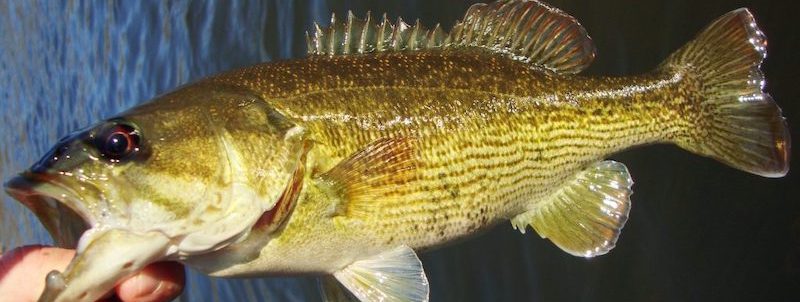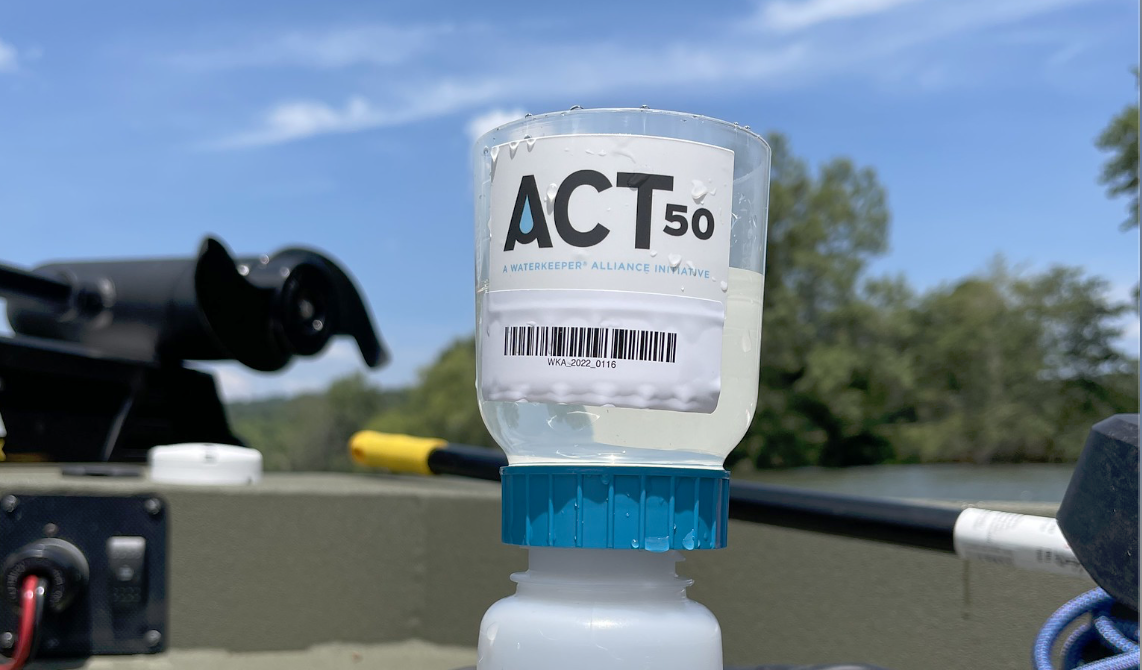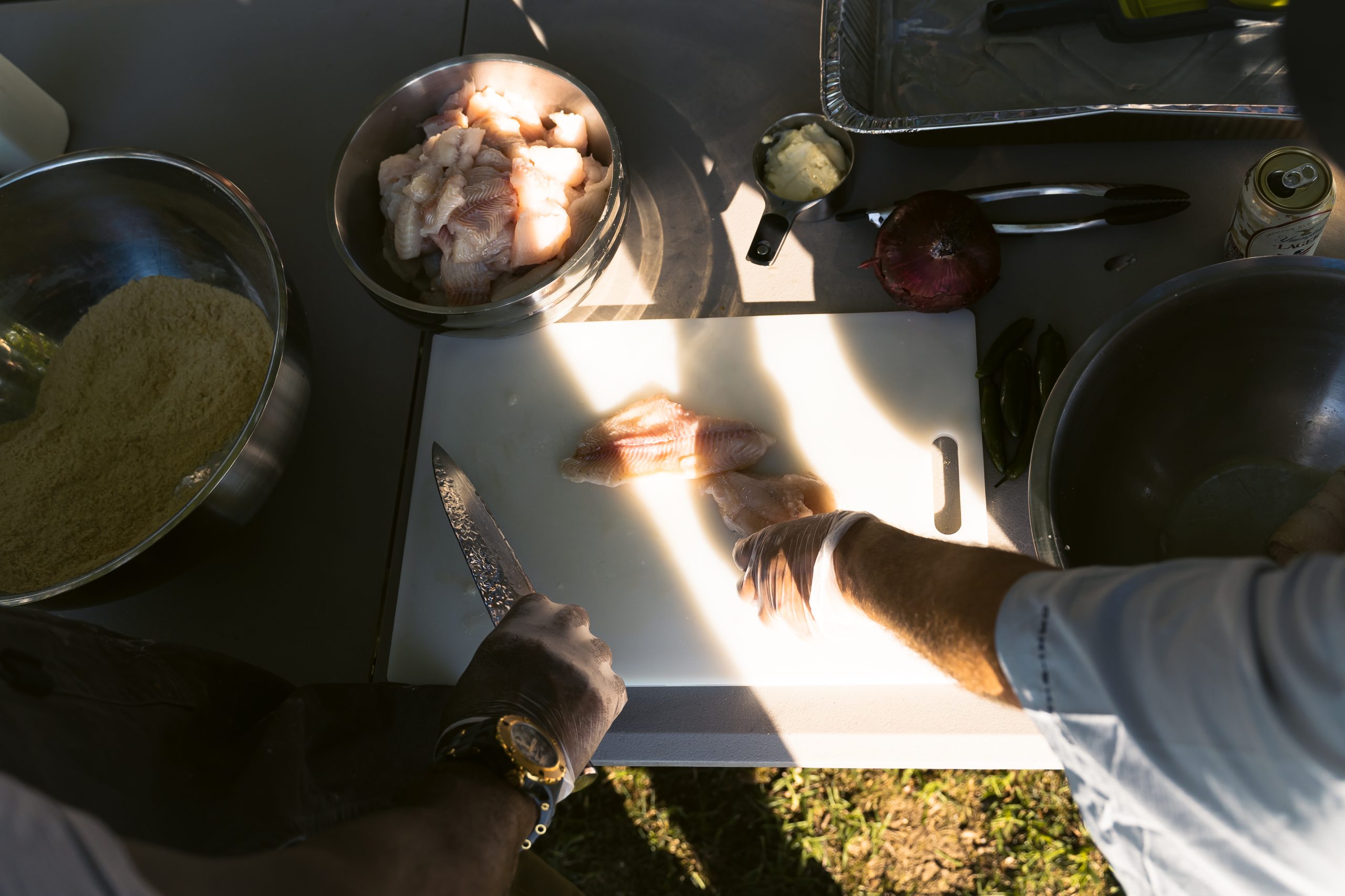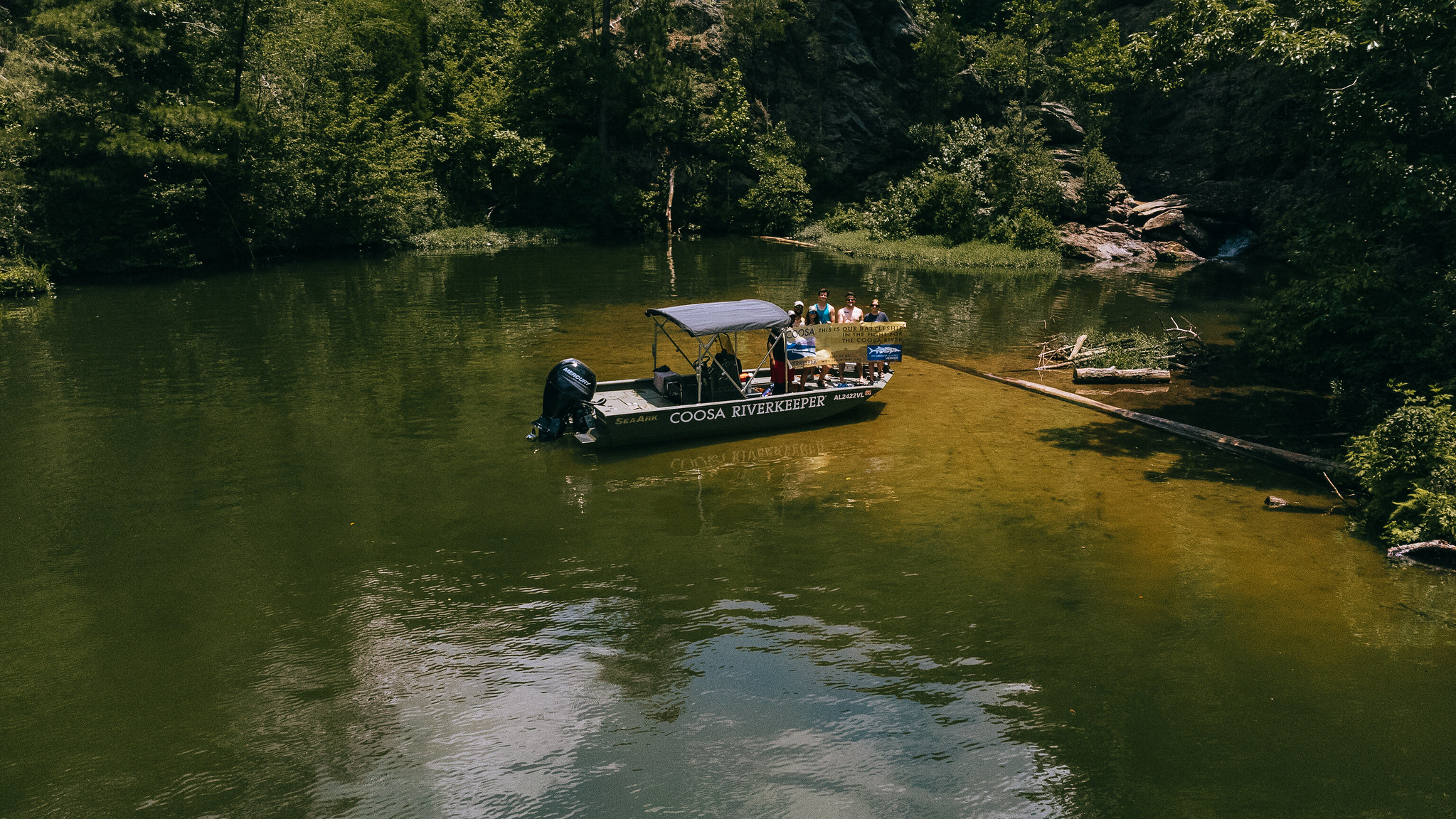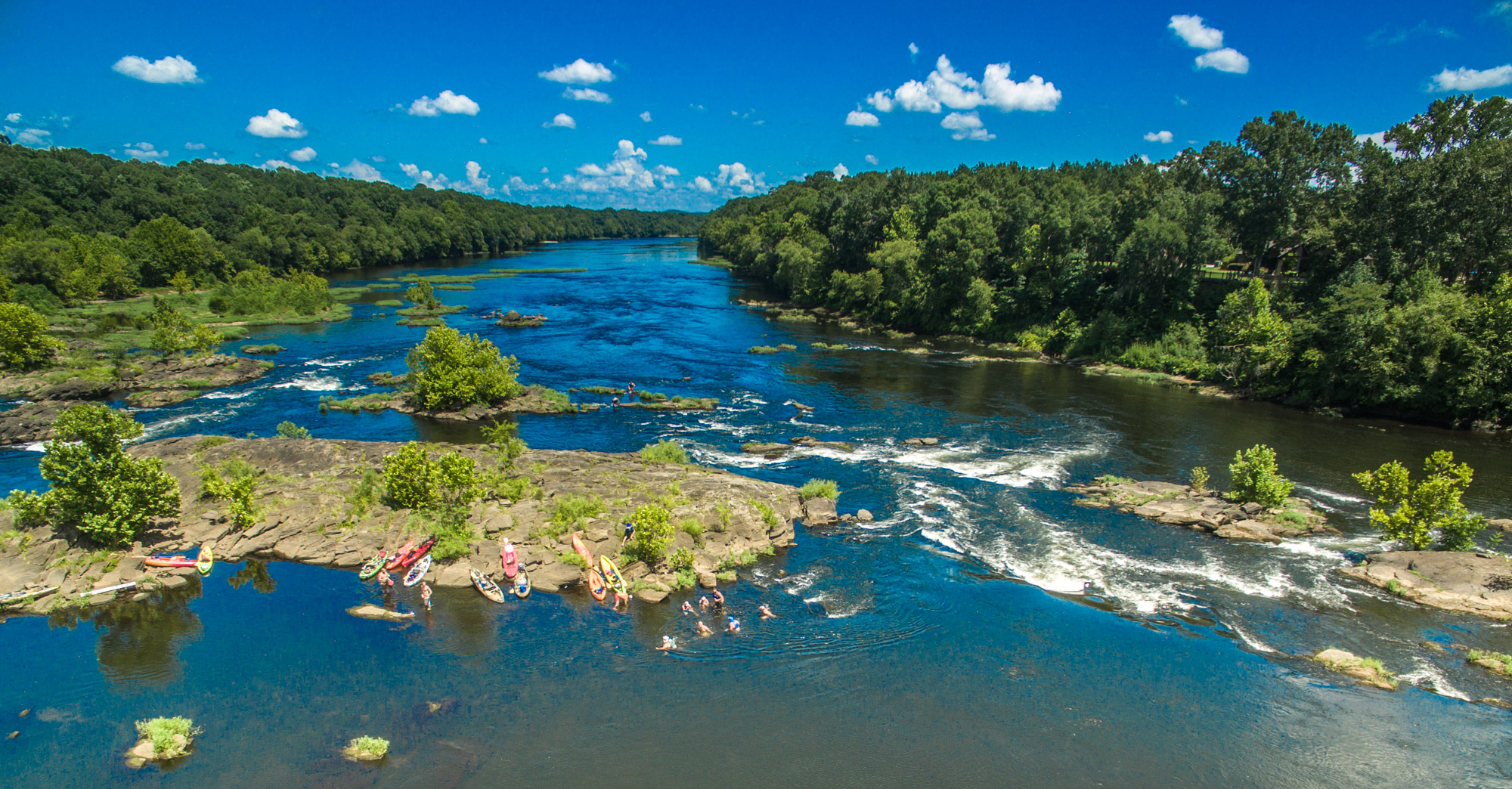Bass
Catfish
Bream
Crappie
Black Bass
Largemouth | Spotted | Redeye
Temperate Bass
Striped | White | Hybrid
The Largemouth Bass
Alabama’s official state freshwater fish

(Micropterus Salmoides)
They are the most popular game fish on the Coosa River and most commonly found in lakes. The state record largemouth, weighing in at 16 lbs 8 oz, came from right here in the Coosa Valley! Largemouth bass grow to the largest size of any black bass. Compared to other black bass, they usually don’t fight very hard, especially in the summer.
Distinguishing Features
A few features distinguish the largemouth:
- Adult size is 12-30 inches.
- Coloring is olive green to brown with a broad black band down the back & a white belly.
- The largemouth: their jaw (when closed) extends past their eye
- They generally do not have teeth on their tongue
- There is only a slight bridge, if any, between the spiny and soft dorsal fins (the ones on top!)
Habitat
Largemouth bass prefer non-flowing, warm water. They tend to flourish in water temperature around 80° to 90°F with an abundance of aquatic vegetation and clear water. They’re found in rivers, lakes and ponds, though lakes provide preferred habitat.
Diet
In stocked ponds, they prey upon sunfish like bluegill and redear. In natural habitats, they prey upon shad, minnows, crawfish, frogs, and other small fish.
Spawn
SPRING, 63-68°F
Largemouth bass usually reach sexual maturity and begin spawning when they are about a year old. Spawning takes place from April to late May, once water temperatures hold steady between 63-68 degrees F.
Advisories
Weiss Lake: Limit consumption of largemouth bass to 1 meal/ month due to PCBs.
Lay Lake: Limit consumption of largemouth bass to 1 meal/ month due to PCBs.
Choccolocco Creek: It is advised to NOT eat any fish caught from Choccolocco Creek due to PCBs.

(Micropterus salmoides)
Largemouth bass (Micropterus salmoides) are the most popular game fish on the Coosa River and most commonly found in lakes. The state record largemouth, weighing in at 16 lbs 8 oz, came from right here in the Coosa Valley from Mountain View Lake on 11/3/1987! Largemouth bass grow to the largest size of any black bass. Compared to other black bass, they usually don’t fight very hard, especially in the summer.
The Spotted Bass
The “Alabama” bass

(Micropterus henshalli)
The Coosa River’s spotted bass (Micropterus henshalli), also known as the Alabama Bass, are some of the meanest fighting fish in the nation! They are found both in the lakes and in creeks. They tend to be more slender and shaped like a football than a largemouth. Because they fight so hard, many a fisherman has been duped into thinking he’s hooked a monster largemouth only to find a smallish spotted bass with a lot of energy. State record catch was 8 lbs 15 oz caught at Smith Lake on 3/18/1978.
The Spotted Bass
The “Alabama” bass
Distinguishing Features
A few features distinguish spotted bass:
- Adult size is 12-17 inches.
- Coloring is mostly olive green with scattered dark mottling.
- Small jaw: Their jaw, when closed, does not extend past the eye.
- They generally have a tooth patch on their tongue.
- There is a significant bridge between the spiny and soft dorsal fins.
- They usually have reddish eyes, but not as bright as the redeye bass!
Habitat
Spotted bass tend to be found in areas with more current than the large mouth, and usually inhabit areas that are too warm, turbid, and sluggish for small mouth bass. They also can be found around aquatic vegetation, submerged logs, & rocks/ riprap walls in moving waterbodies.
Diet
The adults feed on the same foodstuffs as other bass, including worms, leeches, crayfish, fathead minnows, gizzard shad, golden shiners, and other aquatic insects.
Spawn
SPRING, 63-68°F
They spawn in April to May, once water temperatures hold steady around 63-68 degrees F, often in the mouths of tributary streams. The male guards the nest until the fry have hatched.
Advisories
Logan Martin Lake: Limit consumption of spotted bass to 1 meal/ month due to PCBs.
Lay Lake: It is advised to NOT eat any spotted bass due to mercury.
Choccolocco Creek: It is advised to NOT eat any fish caught from Choccolocco Creek due to PCBs.
Redeye Bass
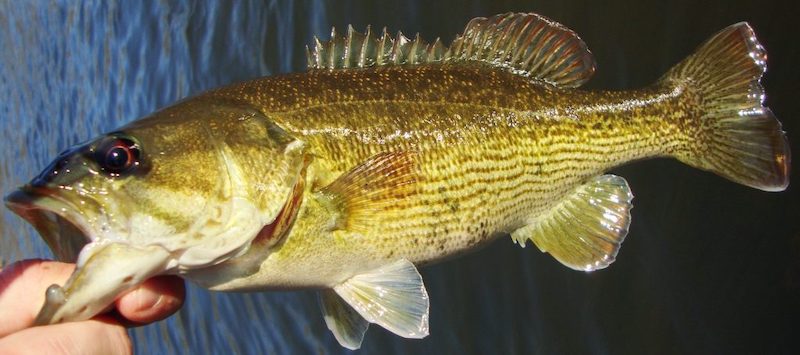
(Micropterus coosae)
The Coosa River’s redeye bass (Micropterus coosae) brings pure joy to the few fishermen that know ’em when they see ’em. The redeye bass are small: the state record redeye came from the Coosa Valley and weighed only 3 lbs 2 oz. The key way to know you’re holding a redeye is that their caudal fins are edged in white, something no other Coosa black bass exhibits. They’re a true delight on a fly rod!Distinguishing Features
A few features distinguish redeye bass:
- Adult size is 14-17 inches.
- Coloring: Red eye bass have beautiful colors, in shades of olive green to brown. They tend to be darker and more mottled than their largemouth and spotted cousins.
- They usually have a tooth patch on their tongue.
- Like spots, they have a significant bridge between the spiny and soft dorsal fins, their jaw does not extend past the eye.
- Generally speaking, redeye bass don’t have a strong horizontal black band down their sides like spots and largemouth tend to, and have the visual appearance more similar to a smallmouth bass.
- Caudal fins (bottom, front fins) are edged in white, a useful feature for distinguishing redeye bass apart.
Habitat
Redeye love moving water and you’ll only find in medium-sized upland streams and creeks. They loathe lake life. They tend to hang out around water willow or other aquatic vegetation like submerged stumps, boulders, or along undercut banks.
Diet
Red eye feed on very small baitfish, crawfish, and both aquatic and terrestrial insects.
Spawn
SPRING, 63-68°F
Redeye spawn from April to June, once water temperatures hold steady around 63-68 degrees F.
Advisories
Choccolocco Creek: It is advised to NOT eat any fish caught from Choccolocco Creek due to PCBs.

(Micropterus coosae)
The Coosa River’s redeye bass (Micropterus coosae) brings pure joy to the few fishermen that know ’em when they see ’em. The state record redeye came from the Coosa Valley on 3/8/2000 and weighed only 3 lbs 2 oz. Per Matt Lewis, author of Fly Fishing for Redeye Bass, there are five formally described species of redeye bass, with each one being endemic to a particular drainage: M. coosae from the Coosa River in AL and GA, M. tallapoosae from the Tallapoosa River in AL and GA, M. cahabae from the Cahaba River in AL, M. warriorensis from the Black Warrior River in AL, and finally M. chattahoochae from the Chattahoochee River in AL and GA.
The Striped Bass
The most notorious game fish of the temperate bass.

(Morone saxatilis)
Striped bass (Morone saxatilis) are the most notorious game fish of the temperate bass. Though they don’t grow incredibly large in the Coosa, their brethren that have more room to stretch their fins grow to huge sizes over 50 pounds and can live well into their twenties. In the summer, they seek out cold water springs and clear water. The state record striped bass was 69 lbs 9 oz, caught on 2/28/2013 at Bankhead Reservoir.
The Striped Bass
The most notorious game fish of the temperate bass.
Distinguishing Features
A few features distinguish striped bass:
- Adult size is 20-24 inches.
- Coloring is dark gray to green on the back with light green to silver sides.
- Striped bass have horizontal black lines along their body which are continuous, but sometimes broken. But, the first stripe below the lateral line is complete all the way to the tail.
- They have two tooth patches on their tongue, compared to one on a white bass.
Habitat
Stripes are anadromous fish, meaning they spend most of their life in saltwater but spawn in freshwater. On the Coosa, of course, they are stuck between two dams and live their entire life in freshwater. This makes it hard for them to sustain their populations. However, on Weiss Lake where stripes have freedom to roam a large territory into Georgia, striped bass now spawn naturally, one of few freshwater populations to do so.
Diet
Spawn
SPRING, 63-68°F
Striped bass reproduce in rivers and brackish areas of estuaries. Spawning occurs from the spring to early summer, with the greatest activity occurring when the water warms to about 65 ° F.
Advisories
Weiss Lake: Limit consumption of striped bass to 1 meal/ month due to PCBs.
Logan Martin Lake: It is advised to NOT eat any striped bass from Logan Martin Lake due to PCBs
Lay Lake: Limit consumption of striped bass to 1 meal/ month due to PCBs.
Choccolocco Creek: It is advised to NOT eat any fish caught from Choccolocco Creek due to PCBs.
The White Bass

(Morone chrysops)
The white bass (Morone chrysops) is similar to the stripe in many ways, but does not grow nearly as large. Their name “chrysops means “golden eye.” They generally spawn in the mouths of creeks in March and April.Distinguishing Features
A few features distingush white bass:
- Adult size is 10-15 inches.
- Coloring is a dark back with silver sides and a white belly.
- The white bass is similar to the stripe in many ways, but does not grow nearly as large. Their body tends to be stockier (more football shaped) and their stripes tend to be fainter.
- They only have one tooth patch on their tongue and the first stripe below the lateral line is broken (not complete).
Habitat
White bass inhabit large reservoirs and rivers in surface and midwater areas. They are found along riprap, downed trees, and other structures below dams. When mating in the spring, they are more often found in shallow rivers, creeks, and streams. White bass are found in high densities in the upstream segment of rivers.
Diet
White bass are aggressive predators that feed mostly on shad, specifically gizzard and threadfin shad.
Spawn
SPRING, 63-68°F
The spawning season for the white bass is mid-March to late May, when water temperatures hold around 54 to 68 °F. They are known to find their home spawning ground even if it is moved to a different part of the same lake. Spawning occurs between one or more males and one female at midwater depths, and then the fertilized eggs drift down to the river bed.
Advisories
Choccolocco Creek: It is advised to NOT eat any fish caught from Choccolocco Creek due to PCBs.

(Morone chrysops)
The white bass (Morone chrysops) is similar to the stripe in many ways, but does not grow nearly as large. Their name “chrysops” means “golden eye.” They are known to grow faster in the Coosa River basin than in Lake Martin or Lake Eufaula. The state record white bass was 4 lbs 9 oz, caught on 2/14/1987 on the Black Warrior River.
The Hybrid Bass

(Morone chrysops x saxatilis)
The striped bass and white bass hybrid (Morone chrysops x saxatilis) is not a natural species. It is created by artificially spawning a male white bass with a female striped bass. The state record hybrid bass was 25 lbs 15 oz, caught on 9/13/1996 on the Sipsey Fork of the Black Warrior River.
The Hybrid Bass
Distinguishing Features
A few features distinguish hybrid bass:
- Adult size of 15-20 inches.
- Coloring is quite variable.
- Like their striped bass mother, they have two tooth patches on their tongue.
- But unlike their mother, the lateral stripes on the lower half of their body are very broken. They also tend to be shorter and thicker.
Habitat
Hybrid striped bass are stocked into a variety of lakes, ponds and reservoirs for fishing purposes. Hybrids do well in slow moving streams, large reservoirs, lakes and ponds. They are seldom found in extremely shallow areas or areas that contain dense growth of aquatic weeds.
Diet
Like both their mother and father, shad is their primary sustenance.
Spawn
Hybrids are stocked by the millions by the Alabama Department of Conservation and Natural Resources and are a common catch, especially below any of the Coosa’s dams. They rarely reproduce naturally.
Advisories
Choccolocco Creek: It is advised to NOT eat any fish caught from Choccolocco Creek.

